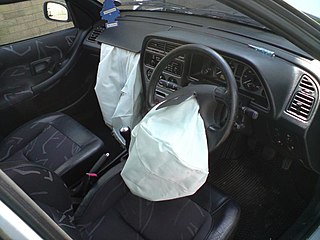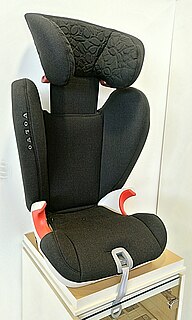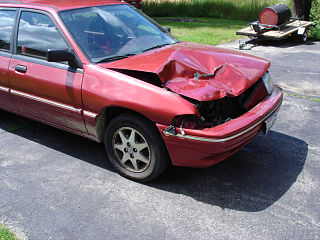
An airbag is a vehicle occupant-restraint system using a bag designed to inflate extremely quickly, then quickly deflate during a collision. It consists of the airbag cushion, a flexible fabric bag, an inflation module, and an impact sensor. The purpose of the airbag is to provide a vehicle occupant with a soft cushioning and restraint during a collision. It can reduce injuries between the flailing occupant and the interior of the vehicle.

Automotive safety is the study and practice of design, construction, equipment and regulation to minimize the occurrence and consequences of traffic collisions involving motor vehicles. Road traffic safety more broadly includes roadway design.

Road traffic safety refers to the methods and measures used to prevent road users from being killed or seriously injured. Typical road users include pedestrians, cyclists, motorists, vehicle passengers, horse riders, and passengers of on-road public transport.

A bumper is a structure attached to or integrated with the front and rear ends of a motor vehicle, to absorb impact in a minor collision, ideally minimizing repair costs. Stiff metal bumpers appeared on automobiles as early as 1904 that had a mainly ornamental function. Numerous developments, improvements in materials and technologies, as well as greater focus on functionality for protecting vehicle components and improving safety have changed bumpers over the years. Bumpers ideally minimize height mismatches between vehicles and protect pedestrians from injury. Regulatory measures have been enacted to reduce vehicle repair costs and, more recently, impact on pedestrians.

The European New Car Assessment Programme is a European voluntary car safety performance assessment programme based in Leuven (Belgium) formed in 1996, with the first results released in February 1997. It was originally started by the Transport Research Laboratory for the UK Department for Transport, but later backed by several European governments, as well as by the European Union. Their slogan is "For Safer Cars".
Seat belt legislation requires the fitting of seat belts to motor vehicles and the wearing of seat belts by motor vehicle occupants to be mandatory. Laws requiring the fitting of seat belts to cars have in some cases been followed by laws mandating their use, with the effect that thousands of deaths on the road have been prevented. Different laws apply in different countries to the wearing of seat belts.

The Insurance Institute for Highway Safety (IIHS) is a U.S. nonprofit organization funded by auto insurance companies, established in 1959 and headquartered in Arlington, Virginia. It works to reduce the number of motor vehicle traffic collisions, and the rate of injuries and amount of property damage in the crashes that still occur. It carries out research and produces ratings for popular passenger vehicles as well as for certain consumer products such as child car booster seats. It also conducts research on road design and traffic regulations, and has been involved in promoting policy decisions.

A side collision is a vehicle crash where the side of one or more vehicles is impacted. These crashes typically occur at intersections, in parking lots, and when two vehicles pass on a multi-lane roadway.

A daytime running lamp is an automotive lighting and bicycle lighting device on the front of a roadgoing motor vehicle or bicycle, automatically switched on when the vehicle's handbrake has been pulled down, when the vehicle is in gear, or when the engine is started, emitting white, yellow, or amber light. Their intended use is not to help the driver see the road or their surroundings, but to help other road users identify an active vehicle.

Guard rail, guardrails, or protective guarding, in general, are a boundary feature and may be a means to prevent or deter access to dangerous or off-limits areas while allowing light and visibility in a greater way than a fence. Common shapes are flat, rounded edge, and tubular in horizontal railings, whereas tetraform spear-headed or ball-finialled are most common in vertical railings around homes. Park and garden railings commonly in metalworking feature swirls, leaves, plate metal areas and/or motifs particularly on and beside gates.

A bullbar or push bumper is a device installed on the front of a vehicle to protect its front from collisions, whether an accidental collision with a large animal in rural roads, or an intentional collision by police with another vehicle. They range considerably in size and form, and are normally composed of welded steel or aluminium tubing, or, more recently, moulded polycarbonate and polyethylene materials. The "bull" in the name refers to cattle, which in rural areas sometimes roam onto rural roads and highways.

A child safety seat, sometimes called a infant safety seat, child restraint system, child seat, baby seat, car seat, or a booster seat, is a seat designed specifically to protect children from injury or death during vehicle collisions. Most commonly these seats are purchased and installed by car owners, but car manufacturers may integrate them directly into their vehicle's design and generally are required to provide anchors and ensure seat belt compatibility. Many jurisdictions require children defined by age, weight, and/or height to use a government-approved child safety seat when riding in a vehicle. Child safety seats provide passive restraints and must be properly used to be effective. However, research indicates that many child safety restraints are often not installed or used properly. To tackle this negative trend, health officials and child safety experts produce child safety videos to teach proper car seat installation to parents and caregivers.

In May 2013 the World Health Organization (WHO) reported that more than 270,000 pedestrians lose their lives on the world’s roads each year, accounting for 22% of the total 1.24 million road traffic deaths. Despite the magnitude of the problem, most attempts at reducing pedestrian deaths had historically focused solely on education and traffic regulation. Since the 1970s, crash engineers have begun to use design principles that have proved successful in protecting car occupants to develop vehicle design concepts that reduce the likelihood of injuries to pedestrians in the event of a car-pedestrian crash. These involve redesigning the bumper, hood (bonnet), and the windshield and pillar to be energy absorbing (softer) without compromising the structural integrity of the car. With the advent of ADAS since 2005, new pedestrian detection and crash avoidance and mitigation systems offer improvements through active rather than passive protection systems. For example, omniview technology allows a driver to see what is around the vehicle before moving.
Reinforced Impact Safety Evolution (RISE) or Realized Impact Safety Evolution is the brand name of Mitsubishi's patented safety body construction system. It was first introduced in the 1996 Mitsubishi Galant. Initially designed to improve passive safety, the system has subsequently been developed to electronically integrate every aspect of car's active and passive safety features.

A tram accident is any accident involving a tram. Alternatively, any accident involving a tram or a tram system may be considered a tram accident. The latter definition is more commonly used in public safety studies.

The automotive steering column is a device intended primarily for connecting the steering wheel to the steering mechanism.

A collision avoidance system (CAS), also known as a pre-crash system, forward collision warning system, or collision mitigation system, is an advanced driver-assistance system designed to prevent or reduce the severity of a collision. In its basic form, a forward collision warning system monitors a vehicle's speed, the speed of the vehicle in front of it, and the distance between the vehicles, so that it can provide a warning to the driver if the vehicles get too close, potentially helping to avoid a crash. Various technologies and sensors that are used include radar (all-weather) and sometimes laser (LIDAR) and cameras to detect an imminent crash. GPS sensors can detect fixed dangers such as approaching stop signs through a location database. Pedestrian detection can also be a feature of these types of systems.

Road traffic collisions generally fall into one of five common types:
Motor vehicle type approval is the method by which motor vehicles, vehicle trailers and systems, components and separate technical units intended for such vehicles achieve type approval in the European Union. There is no EU approval body: authorized approval bodies of member states are responsible for type approval, which will be accepted in all member states.
Charles Adrian Hobbs is a safety expert in vehicle crashworthiness with a background in accident and injury investigation, and analysis.



















